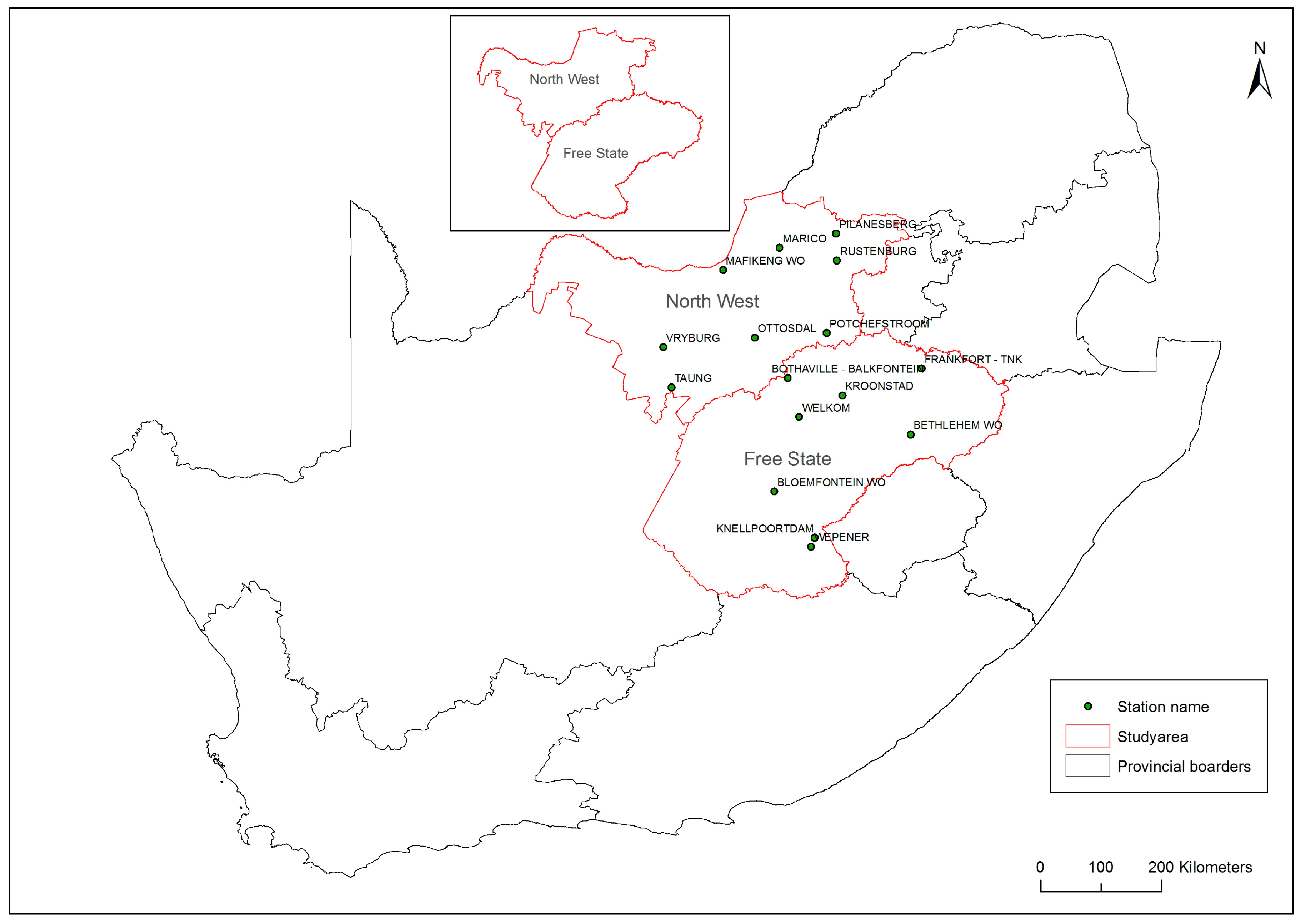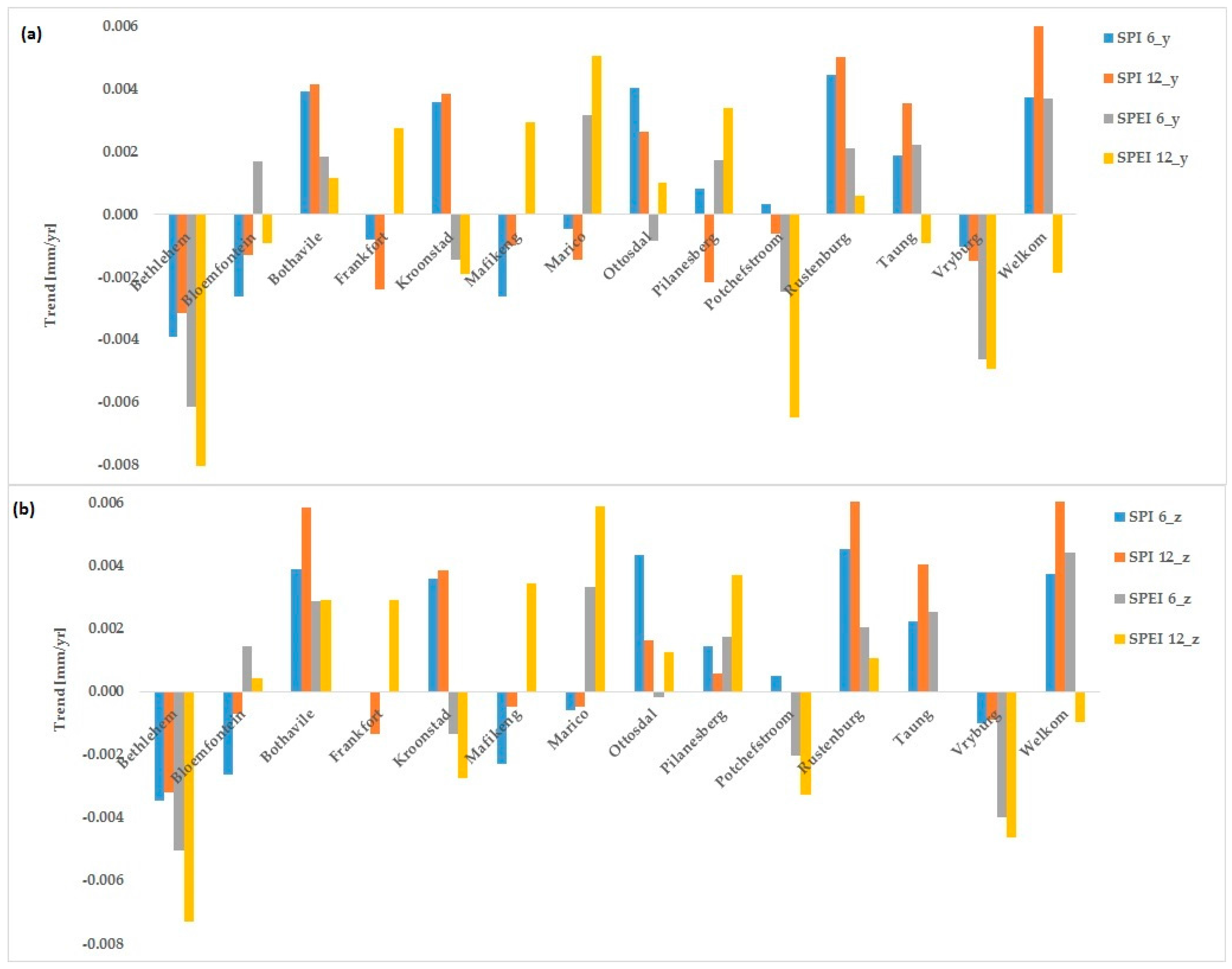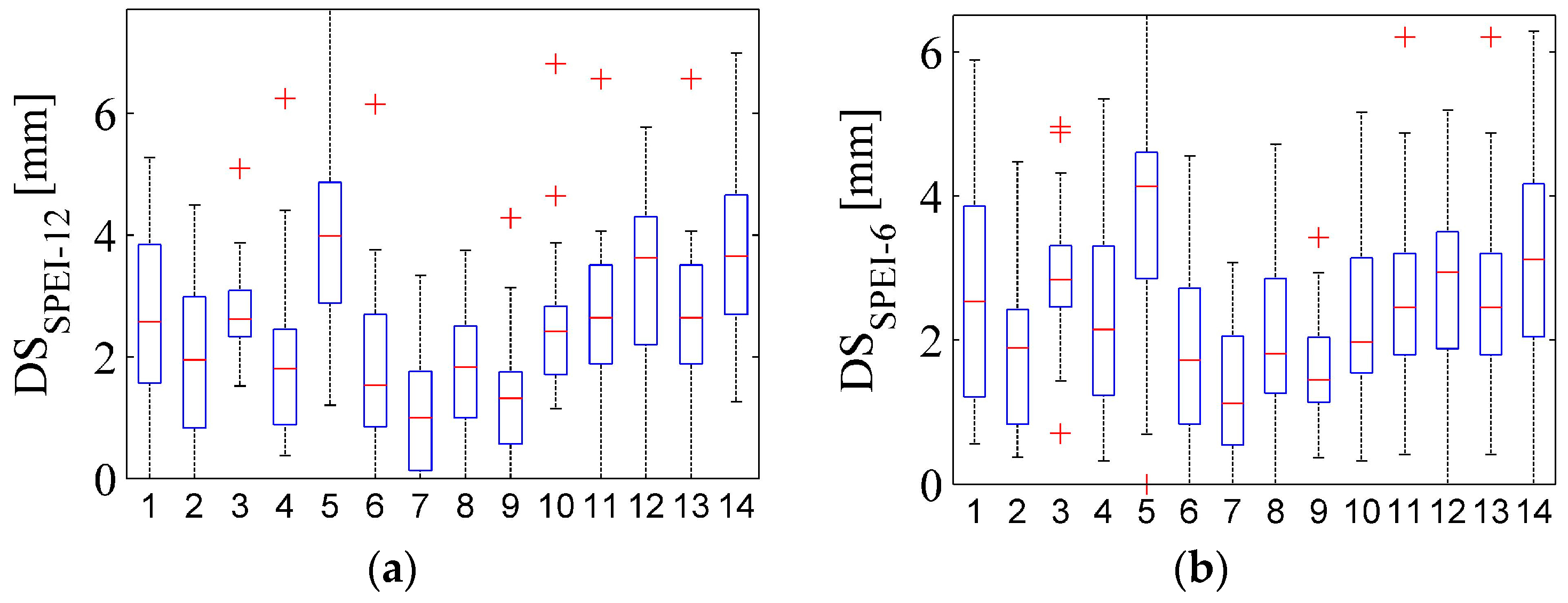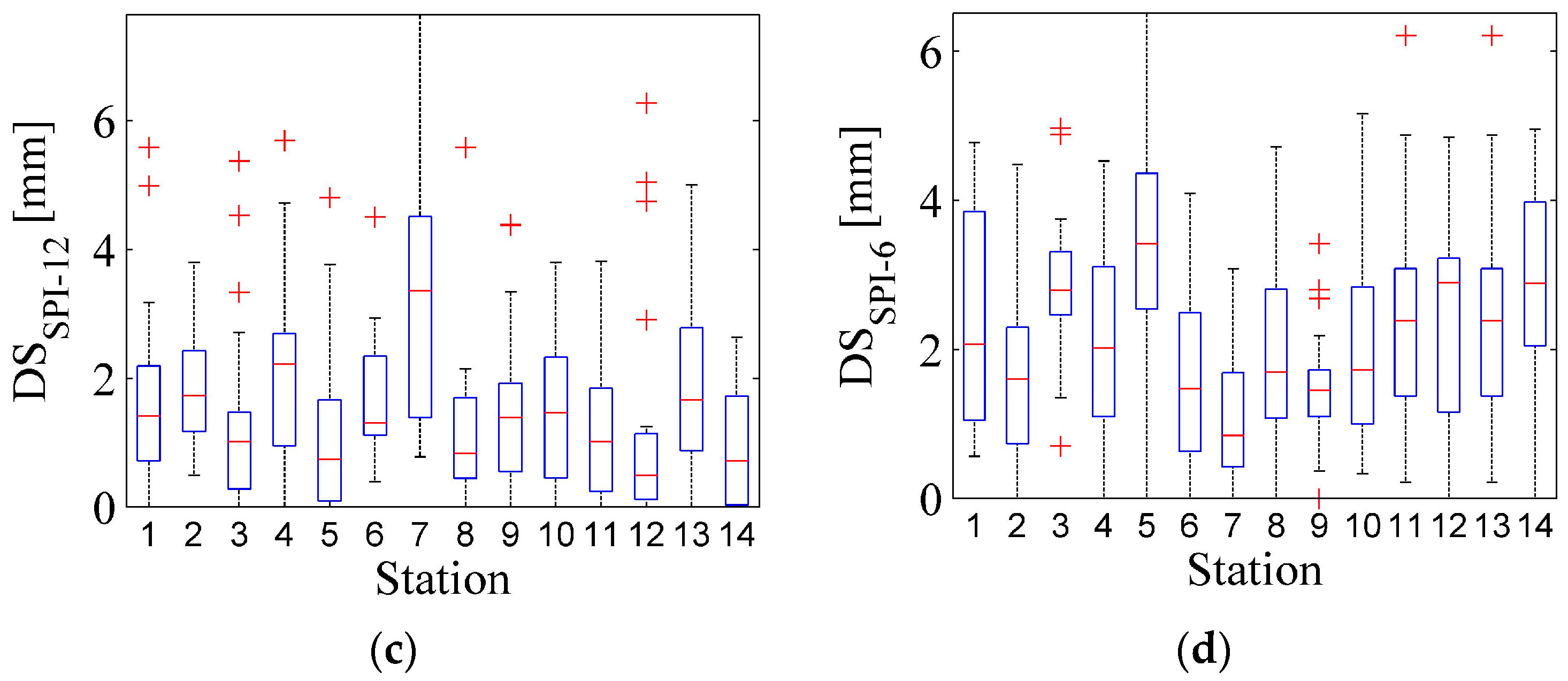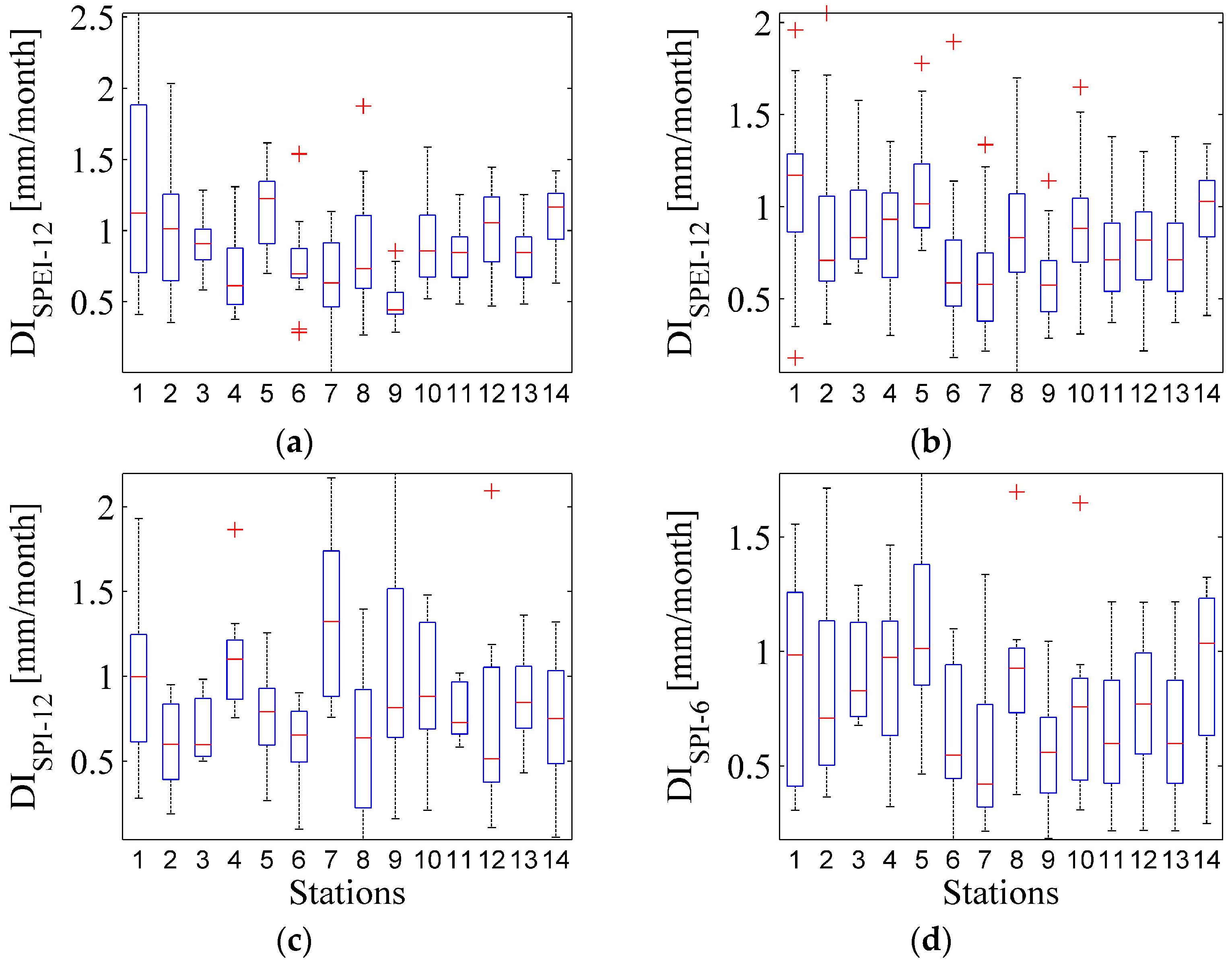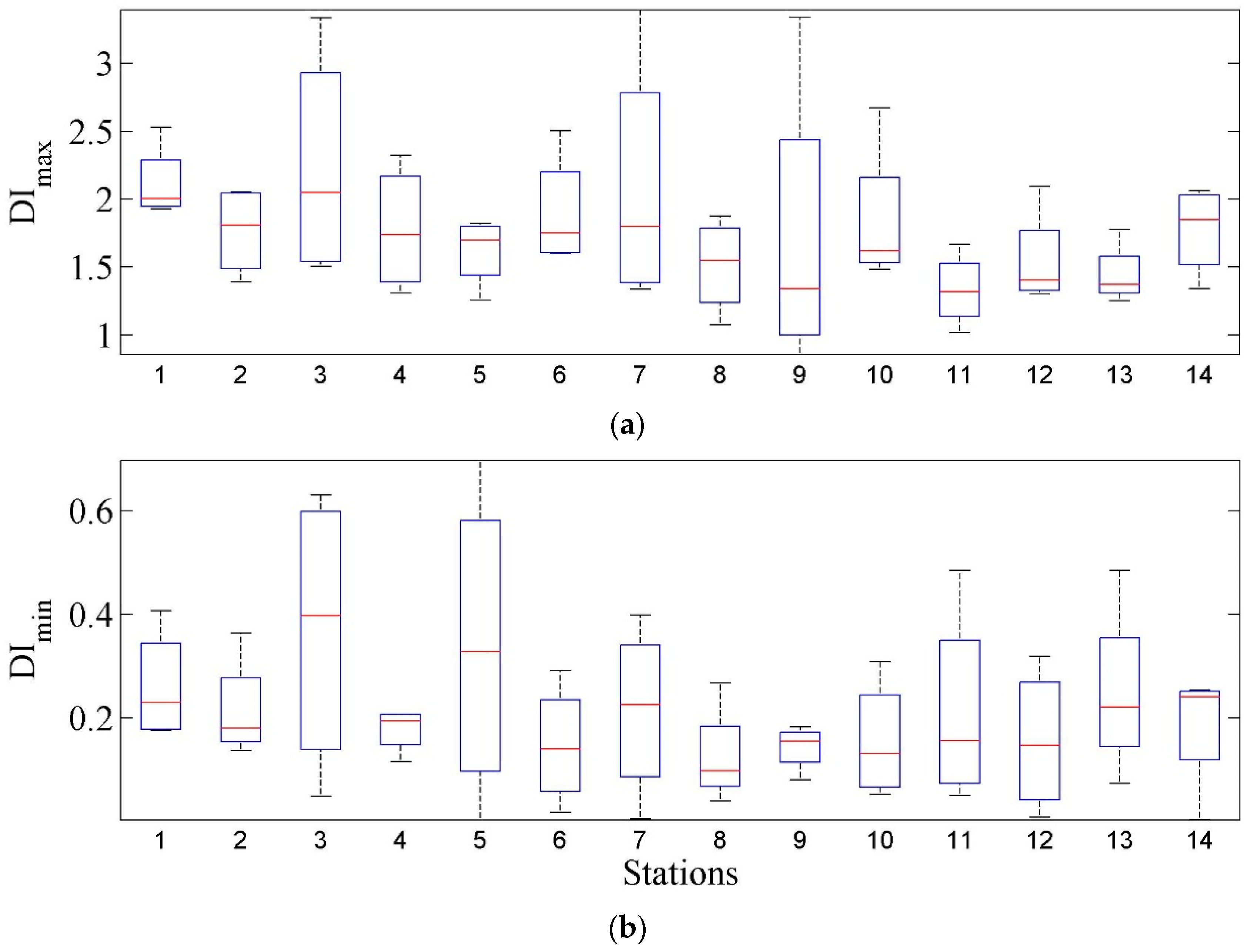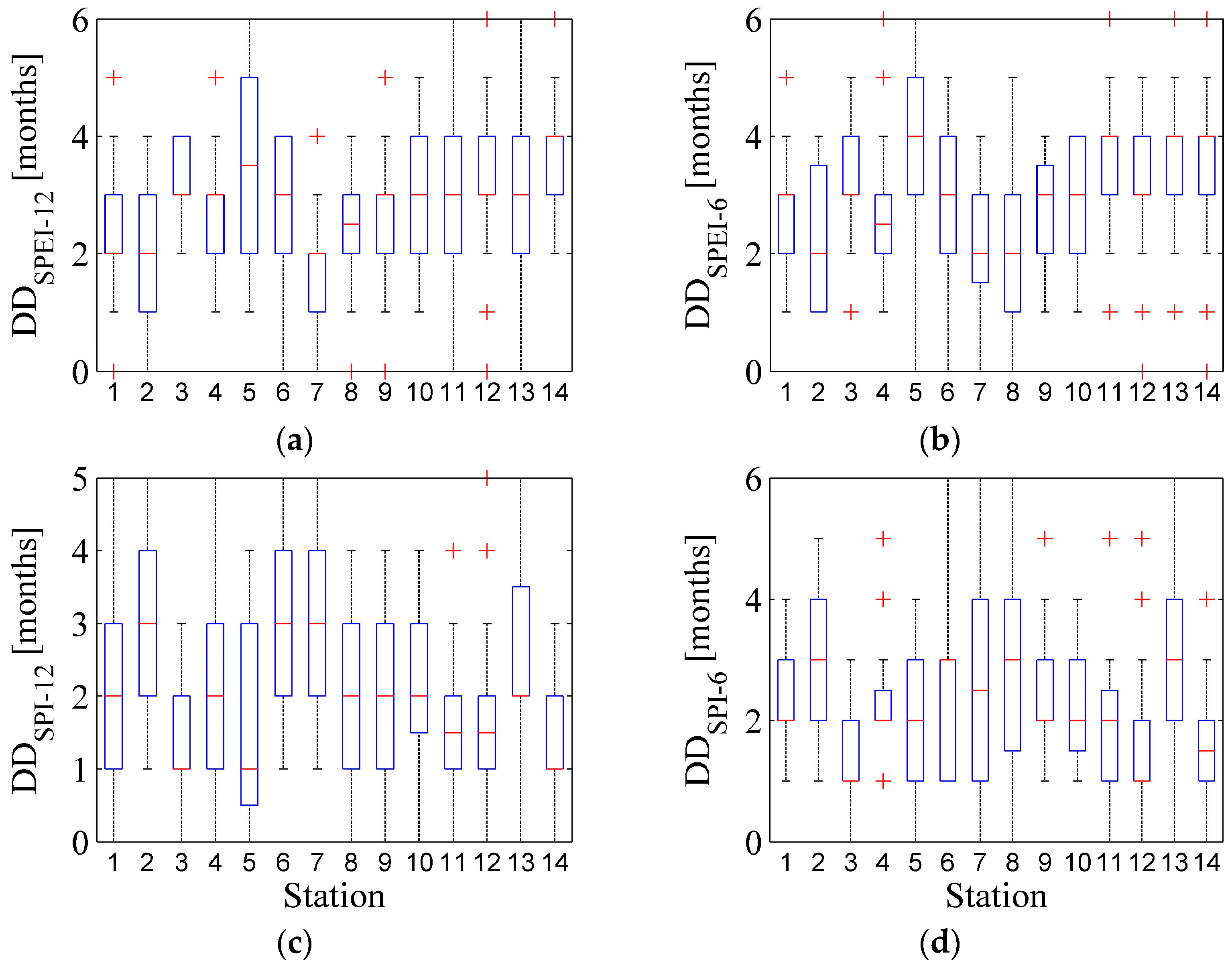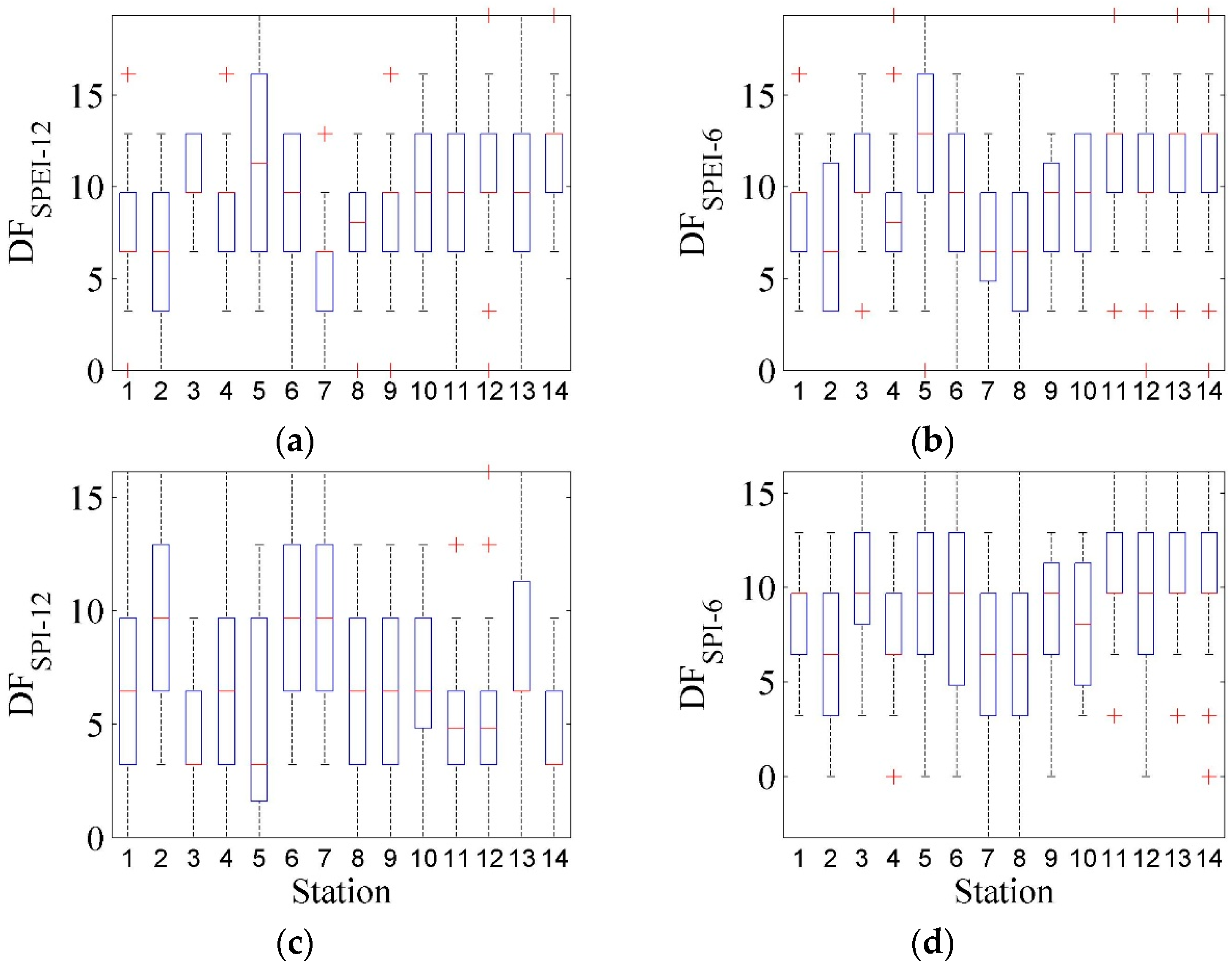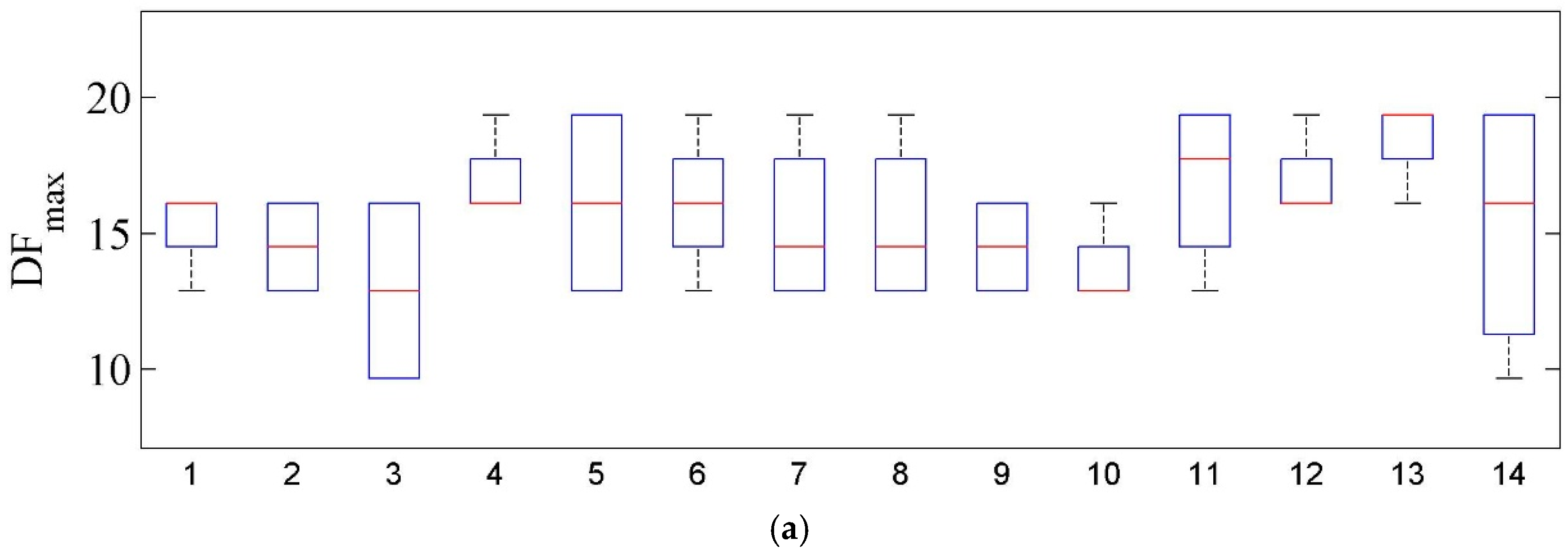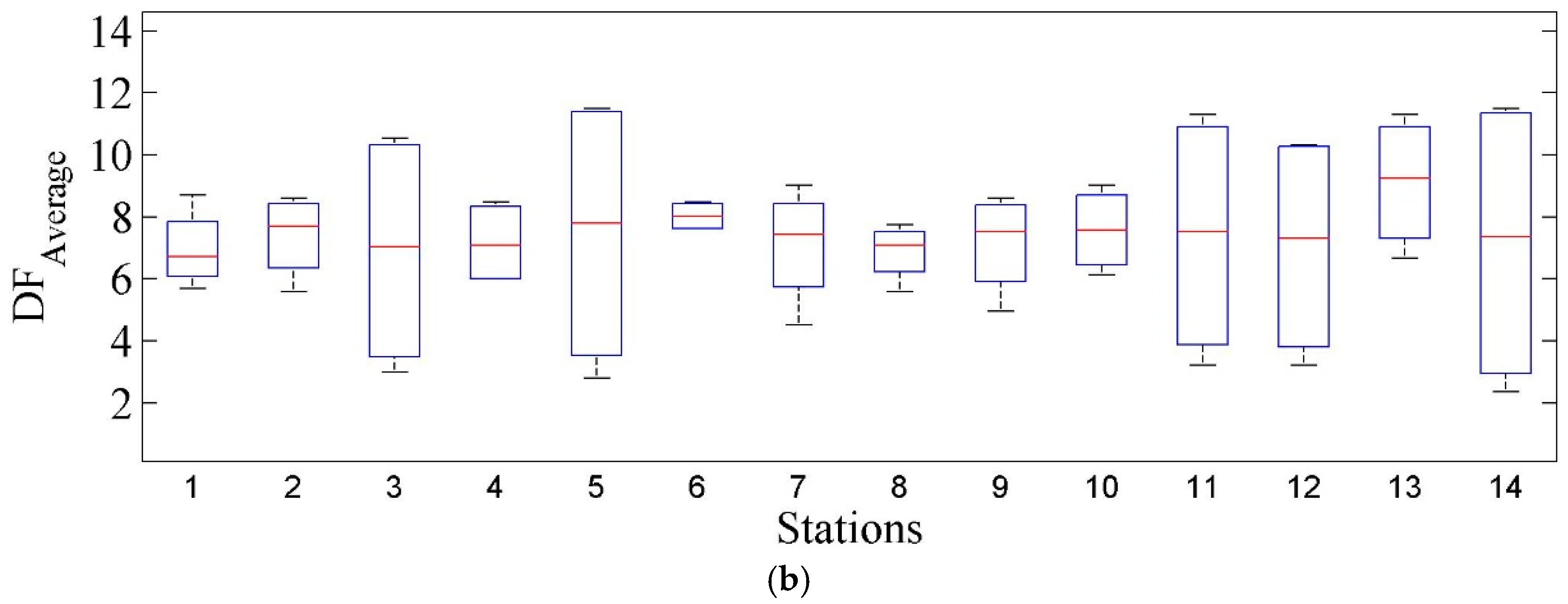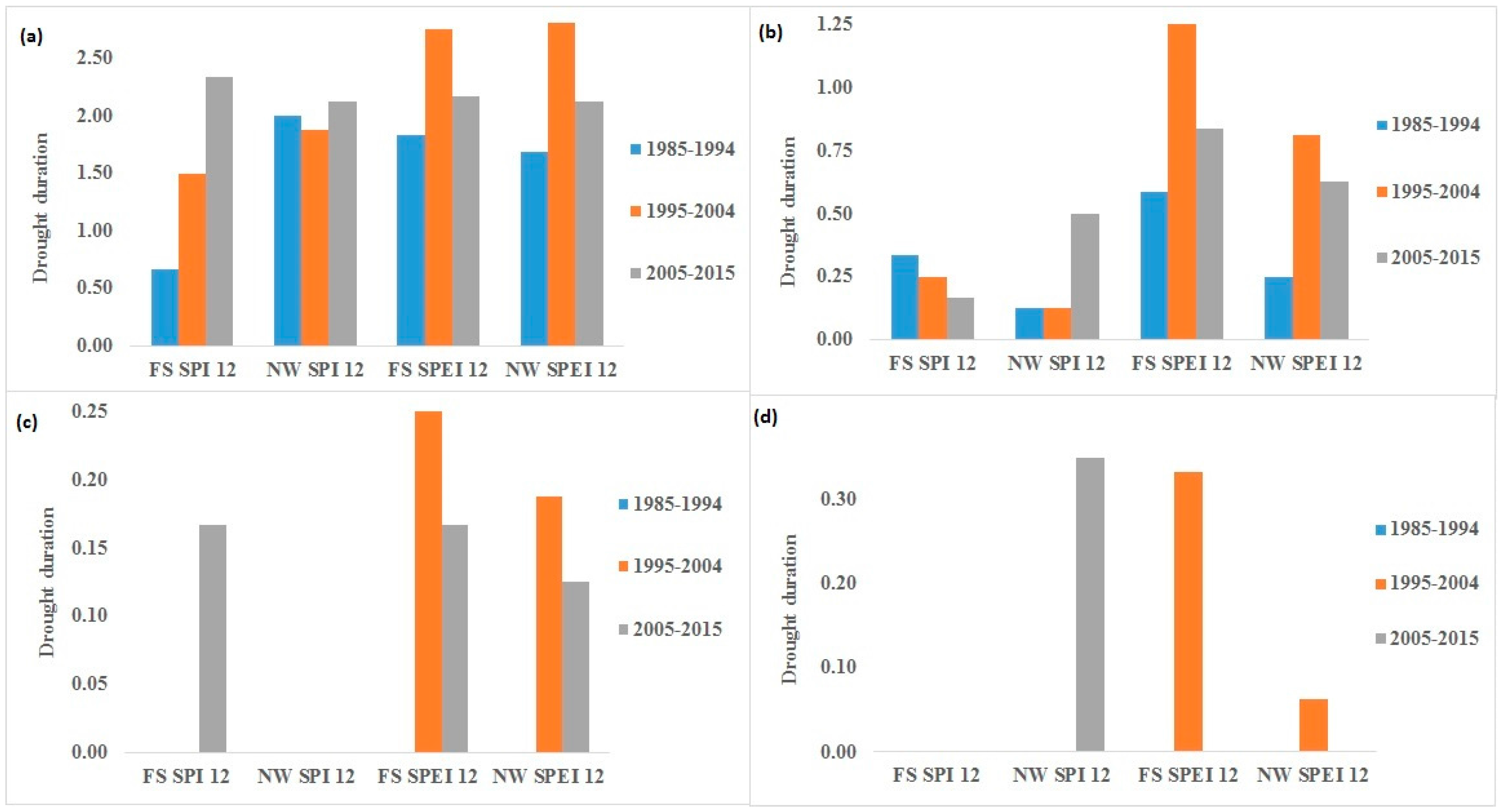1. Introduction
Extreme Earth systems processes have continued to manifest in terms of natural hazards whose impacts are felt by the entire ecosystem including mankind. Drought is one such extreme physical process and is often characterized as a slow-onset natural hazard whose impacts are complex and reverberate through many sectors of the economy such as water resources, agriculture, and natural ecosystems [
1,
2]. Furthermore, there is a compelling body of knowledge that link droughts to other epidemics like famine, diseases and land degradation globally. The inherent characteristics and impacts of droughts on the ecosystem and society at large has made drought the subject of numerous studies (e.g., see [
3,
4,
5,
6] and references therein).
To this end, a precise, unequivocal definition of drought remains elusive. Various definitions of drought have been suggested in the literature, all relating to specific drought impacts on economic activities, ecosystems, and society and water management issues [
7,
8,
9,
10]. A review by Dracup et al. [
7] and Wilhite and Glantz [
8] alluded to drought as a condition of insufficient moisture caused by a deficit in precipitation over some time period. According to Pereira et al. [
11], drought can be defined as a temporal imbalance of water availability consisting of a persistent lower than average precipitation of uncertain frequency, duration and unpredictable severity. In Vicente-Serrano et al. [
2] and references therein, drought is described as a natural phenomenon which occurs when water availability is significantly below normal levels over a long period of time and cannot meet demand.
As reported in Halwatura et al. [
12], drought periods can be characterized from a few hours (short-term) to millennia (long-term). The time lag between the beginning of a period of water scarcity and its impact on socio-economic and/or environmental assets is referred to as the timescale of a drought [
13]. As a result, drought indices usually consider short-term droughts (three months or less), medium-term droughts (lasting 4–9 months) and long-term droughts (12 months or more). Short-term droughts have an impact on water availability in the vadose zone and therefore are largely meteorological and agricultural droughts. On the other hand, long-term droughts also affect surface and ground water resources and therefore hydrological drought.
According to Byun et al. [
14], drought impacts result from a deficiency of surface or subsurface water components of the hydrologic system. The first component of the hydrologic system to be affected is usually soil moisture. As the duration of the event continues, other components will be affected. This implies that the impacts of drought gradually spread from the agricultural sector to other sectors and finally a shortage of stored water resources becomes detectable. In this regard, drought manifests in two folds: (a) a shortage of soil moisture; and (b) shortages of water stored in other reservoirs. The two manifestations are generally as a result of deficiency of precipitation at different time scales. As reported in, e.g., Wilhite [
9], identifying drought onset, end, extent and severity is very difficult because drought causal factors are often intertwined and become apparent after long period of precipitation deficit.
In the absence of a single, common and precise definition of drought, policy-makers, resource planners and other related groups are confronted with challenges when trying to recognize and plan for drought than they often do for other natural disasters. As a result, countries worldwide have begun to set up national drought strategies that include development of comprehensive drought monitoring systems that are capable of providing early warnings of the drought’s onset as well as to determine drought severity and spatial extent and convoy the information to decision-makers timely. Such information can be used to reduce or avoid the imminent negative impacts of drought.
Drought experts around the world have focused on developing standards for drought indices that can be used to monitor the spatio-temporal characteristics of soil moisture drought [
15,
16,
17]. In particular, numerous drought indices have been developed globally. Some of these indices are derived from precipitation only (e.g., SPI), precipitation and evapotranspiration (e.g., SPEI) while other are computed from a combination of several agro-hydro meteorological parameters. All these drought indices are used to monitor the three most common types of drought, namely meteorological, hydrological and agricultural. Examples of such indices are summarized in
Table 1, and their strengths, weakness and limitations can be found in review studies by Quiring [
18], Mishra and Singh [
19] and Zargar et al. [
20].
Drought indices are often selected based on the nature of the indicator, local conditions, data availability and validity. The Standardized Precipitation Index (SPI) is the most popular meteorological drought index, computed based on long data records of precipitation (e.g., >20 years) only. In calculating SPI, it is often assumed that the precipitation and other meteorological factors are stationary with no temporal trends [
25]. The Standardized Precipitation Evapotranspiration Index (SPEI), reported in, e.g., Vicente-Serrano et al. [
25], is a modification of SPI that takes into account the effects of evapotranspiration. According to Vicente-Serrano et al. [
25], SPEI is computed at various temporal scales based on non-exceedance probability of precipitation and potential evapotranspiration differences. The index has the capability to depict the multi-temporal nature of drought. Both SPI and SPEI can be calculated on different timescales, with 1-, 3-, 6-, 12- and 24-months being commonly used [
6]. Drought at 1-, 3-, and 6-month timescales is relevant for agricultural impacts, while 12- and 24-month scales are relevant to hydrological and socio-economic impacts, respectively [
26].
The SPI and SPEI drought indices have been applied in various studies focusing on drought monitoring as well as prediction of drought class transitions. In particular, a number of studies, including Paulo et al. [
27] and Paulo et al. [
28] and references therein, have suggested that SPI is more superior, particularly, for drought monitoring purposes. A comparison study of the SPI and SPEI indices at 9- and 12-month time scales reported in Paulo et al. [
29] found that SPI and SPEI produced similar results for the same time scales concerning drought occurrence and severity. On the other hand, analysis of SPI and SPEI by Tan et al. [
3] suggested that SPEI is instead more applicable than SPI for exploring the spatial-temporal evolution of climate change and drought variation in Ningxia. A multiple timescales study by Törnros and Menzel [
30] highlighted the importance of selecting a correct choice of SPEI/SPI timescale when addressing drought conditions related issues under changing conditions. In particular, the authors identified a 6-month SPEI timescale as the most appropriate index, and suggested that a very short timescale would probably fail to detect longer periods of abnormal wet/dry conditions while redundant information is likely to be included if a very long timescale is considered. Studies involving prediction of drought class transitions include among others, Moreira et al. [
31], Paulo and Pereira [
32], Moreira et al. [
33] and references therein.
Application of both SPI and SPEI as drought indicators during monitoring of drought events provides better approach in understanding the response of natural and man-made ecosystem in terms of water supply-demand [
34] as well as understanding the evolution of drought in selected areas of interest. This study aims to characterize the nature of droughts over Free State (FS) and North West (NW) Provinces, South Africa based on the SPI and SPEI drought monitoring parameters. Generally, South Africa is classified as a semi-arid and water stressed country. The country’s average annual rainfall is about 450 mm a year, which is below the world’s 860 mm average per year. In particular, rainfall in South Africa exhibits seasonal variability, with most rainfall occurring mainly during summer months (November through March). However, in the southwest region of the country, rainfall occurs in winter months (May through August). South Africa experiences rainfall that varies significantly from west to east. Annual rainfall in the northwest region often remains below 200 mm, whereas much of the eastern Highveld receives between 500 mm and 900 mm (occasionally exceeding 2000 mm) of rainfall per annum. The central part of the country receives about 400 mm of rain per annum, with wide variations occurring closer to the coast. Most regions receiving 400 mm of rainfall play a significant role, e.g., land to the east are suitable for growing crops while land to the west are suitable for livestock grazing as well as crop cultivation on irrigated land. The FS and NW Provinces fall within regions that receive less than 500 mm of rainfall per year, and play an important role towards South African economy. In this regard, the objective of our analysis is focused on investigating historical drought conditions over the two provinces of South Africa, which mainly harbor agricultural production and have the country’s major water reservoirs. Drought characterization over these provinces is valuable in respect of understanding the risks of droughts and determination of the impacts of droughts on agriculture and water resources. A quantitative analysis of Drought Evaluation Indicators (DEIs) such as duration, severity, intensity and frequency (including underlying probability distributions in the DEIs) over southern Africa is, to our knowledge, inconclusive or completely lacking in the literature. Therefore, this study contributes to the theoretical body of knowledge of droughts (through expounding the nature of trends in the DEIs). Results of this work could contribute towards the design of drought preparedness plans in a bid to manage future anticipated drought impacts in South Africa.
2. Study Area
This study focused on two of the nine provinces of South Africa, FS and NW, see
Figure 1. Free State is the third largest province in South Africa in terms of land area, with approximately 129,825 km
2. This represents a 10.6% of the country’s land area [
35]. The province is situated between latitudes 26.6° S and 30.7° S and between longitudes 24.3° E and 29.8° E. It borders Lesotho and six other provinces, namely: Northern Cape, North West, Gauteng, Mpumalanga, Eastern Cape and KwaZulu-Natal. The main economic activities contributing significantly towards the gross domestic product of the province are community service (24.7%), agriculture (20.1%), trade (10.7%) and mining (9.6%) [
36]. Free State Province contributes significantly to the agricultural economy of the country, e.g., approximately 30% of the national maize production is from the Free State [
37]. Agriculture in the province is highly dependent on rainfall, only 10% or less of the arable land is under irrigation. On the one hand, NW Province is situated towards the western part of South Africa and it borders Limpopo Province to the North, Gauteng to the East, FS to the East and South, Northern Cape to the South-West and Botswana to the West and North (see
Figure 1). NW Province has a total land area of 116,320 km
2 and it occupies 9.5% of the total area of South Africa. It is predominantly rural at 65% and 35% urban with agriculture being the main activity. Its land can be characterized as follows: 28% potentially arable, 56.8% grazing, and 14.9% conserved (e.g., for game reserves and housing).
FS and NW Provinces exhibit numerous but significant characteristics that contribute to the country’s economy. For example, in the national context, the NW Province is the highest in cereal and oil seeds production followed by FS. In addition, NW is the highest sheep producer (31.55%) followed by FS, and second largest cattle produce at 17.11% after FS Province [
38]. Nevertheless, various constraints, including the lack of or insufficient water, impede farmers from farming effectively. With the recent drought conditions experienced in various parts of South Africa, farmers are battling to keep their animals and crops alive. Most of the farmers in NW and FS rely on rainfall for agriculture activities. Therefore, insufficient rainfall, which ultimately leads to drought, means increased feed costs for the farmers and the few with irrigation schemes will have to pay more costs for irrigation. In recent months, NW and FS Provinces were declared drought disaster areas following the unprecedented poor rainfall and heat waves. The two provinces were selected in this study to investigate the evolution of drought over the past 30 years.
5. Discussion
South Africa has suffered one of the worst droughts of the century. It has been linked to climate change and the recounting El Niño phenomenon, which warms surface waters in the eastern tropical Pacific Ocean. The ensuing lack of rain and soaring temperatures have decimated the agricultural sector and forced urban water restrictions as the water reservoirs continue to be below 50% capacity. Having been inundated by these conditions, the present study characterized the nature of historical drought conditions across two South African provinces, often considered to be central for food and water security of the country. In particular, the study considered a drought characterization metric consisting of the drought duration, drought severity, intensity and frequency as drought monitoring indicators. While illustrating that the characteristics of droughts exhibit subtle trends, the duration, severity, intensity of droughts in the two provinces exhibit noticeable spatial-temporal differences. These findings have critical implications to both the agricultural sector and water resources in South Africa, which is already categorized as a water stressed country.
5.1. Implications to the Agricultural Sector
Droughts often manifest in terms of lack of rainfall and high temperatures. These two climate parameters are the key drivers of the hydrological cycle. A disturbance in any one component or process of the hydrological cycle has impacts on the agricultural cycle. To this end, the immediate consequence of drought is a fall in crop production, due to inadequate and poorly distributed rainfall. Additionally, livestock production is impacted due to low rainfall, which causes poor pasture growth and may also lead to a decline in fodder supplies from crop residues. It is therefore important to understand the characteristics of historical droughts in order to quantitatively determine their impacts to the Agricultural production in the two provinces. This information is especially important, as it could enable stakeholders to develop robust drought monitoring and forecasting tools in support of preparedness for future droughts under changing climate. In this regard, characterizing droughts in the two provinces would enable farmers to make informative decisions related to weather/climate impacts relevant to them.
5.2. Implications to Water Resources
South African water reservoirs have depicted continuous decline over a period of time in corroboration with decreases in the amount and irregularity in the amount of rainfall received throughout the country (in general) and the two provinces (in particular). The status quo of the water reservoirs is expected to be maintained because of the linkage between climate change and variability and the precipitation, run off, evapotranspiration, soil moisture and stream flow. The underlying processes influencing the dynamics of these linkages are complex and remain a hot subject in earth–atmosphere interactions research. Through drought characterization of drought metrics derived from SPI-12 and SPEI-12 work reported in this paper, it is hoped that the hydrological drought monitoring and forecasting efforts would be the backbone of robust water resources planning across the two provinces. The planning is no doubt significant for reducing the economic, social and environmental negative impacts of changes in weather and climate.
